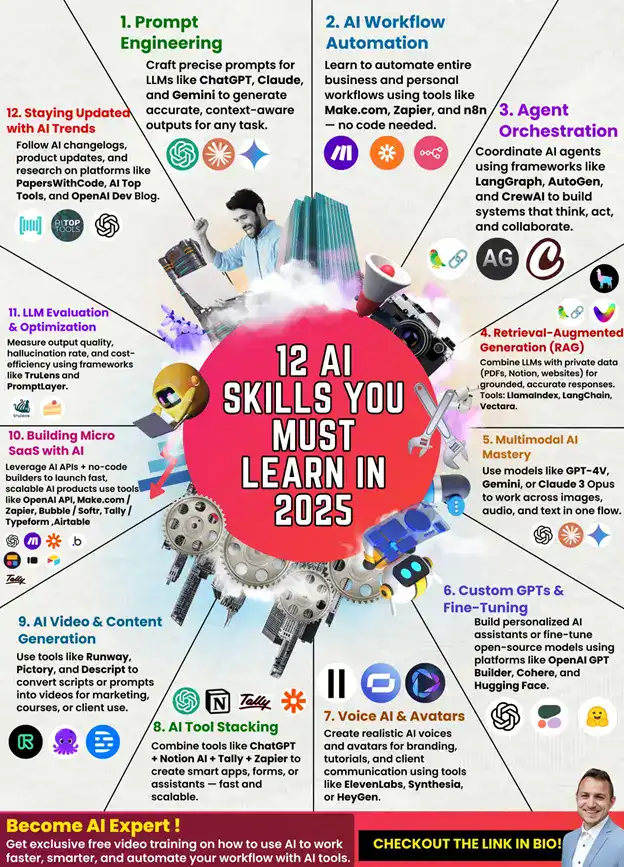Artificial Intelligence is transforming industries, careers, and how we solve problems daily. The infographic 12 AI Skills outlines critical competencies needed to harness AI’s full potential—whether you’re a developer, entrepreneur, or professional looking to future-proof your career. Below, we explore each skill in detail and how you can apply them to work smarter and stay ahead in the AI revolution.

1. Prompt Engineering
Mastering the art of communicating with AI models is foundational. Tools like ChatGPT, Claude, and Gemini respond to well-structured prompts with higher accuracy and relevance.
Key Applications:
- Crafting precise queries for research, content generation, or coding assistance
- Using techniques like few-shot prompting (providing examples) to improve outputs
- Iteratively refining prompts based on model responses
Tip: Start by studying prompt frameworks (e.g., “Act as an expert in [field]…”) and experiment with specificity.
2. AI Workflow Automation
Automate repetitive tasks using no-code platforms like Make.com, Zapier, or n8n. These tools connect apps and trigger actions without programming.
Example Workflows:
- Auto-save email attachments to Google Drive
- Sync CRM updates with Slack notifications
- Generate AI reports from spreadsheet data
Business Impact: Saves hours per week, reduces human error, and scales operations effortlessly.
3. Agent Orchestration
Coordinate multiple AI agents to collaborate on complex tasks. Frameworks like LangGraph, AutoGen, and CrewAI enable agents to specialize (e.g., researcher, writer, reviewer) and work sequentially.
Use Cases:
- Automated customer support triage
- Multi-step content creation (research → draft → edit)
- Data analysis pipelines
Why It Matters: Mimics team dynamics for end-to-end problem-solving.
4. Retrieval-Augmented Generation (RAG)
Ground AI responses in your data by integrating LLMs with documents (PDFs, Notion, databases). Tools like LlamaIndex and LangChain fetch relevant information before generating answers.
Applications:
- Company-specific Q&A chatbots
- Legal/financial document analysis
- Personalized learning assistants
Advantage: Reduces hallucinations and improves accuracy for niche topics.
5. Multimodal AI Mastery
Process images, audio, and text in unified workflows. Models like GPT-4V, Gemini, and Claude 3 Opus can analyze screenshots, transcribe meetings, and generate image descriptions.
Examples:
- Turn whiteboard sketches into code
- Extract text from videos for SEO
- Create audio summaries of long reports
Future-Proof Skill: As AI moves beyond text, multimodal fluency will be indispensable.
6. Custom GPTs & Fine-Tuning
Tailor AI to your needs by fine-tuning open-source models (e.g., via Hugging Face) or building Custom GPTs (OpenAI’s GPT Builder).
Scenarios:
- Industry-specific assistants (e.g., medical diagnosis support)
- Brand-aligned content generators
- Coding helpers trained on your codebase
Pro Tip: Start with low-code platforms before diving into model training.
7. Voice AI & Avatars
Create synthetic voices and digital humans with ElevenLabs, HeyGen, or Synthesia for engaging tutorials, ads, or client communications.
Innovations:
- Multilingual voiceovers with consistent tone
- Personalized video messages at scale
- Interactive AI receptionists
Ethical Note: Always disclose AI-generated media to maintain trust.
8. AI Tool Stacking
Combine tools like ChatGPT + Notion AI + Zapier to build powerful apps. For instance:
- AI form assistants (Tally + GPT)
- Smart knowledge bases (Notion AI + RAG)
- Automated content calendars (Make.com + Claude)
Scalability: Stacks enable rapid prototyping without coding.
9. AI Video & Content Generation
Produce videos from text using Runway, Pictory, or Descript. Ideal for:
- Turning blogs into social media clips
- Generating product demos
- Localizing content with AI dubbing
Time-Saver: Cuts video production time from days to minutes.
10. Building Micro SaaS with AI
Launch lightweight AI products by connecting APIs (OpenAI, Anthropic) to no-code platforms like Bubble or Softr. Examples:
- Niche copywriting tools
- AI-powered resume reviewers
- Custom chatbots for small businesses
Monetization: Low overhead with subscription or pay-per-use models.
11. LLM Evaluation & Optimization
Measure AI performance with tools like Trulens or PromptLayer to track:
- Hallucination rates
- Cost per query
- Response quality
Critical for: Deploying reliable, cost-effective AI solutions.
12. AI Ethics & Compliance
(Note: Though not listed in the infographic, this is a vital 12th skill.)
Navigate biases, privacy, and regulations (e.g., GDPR, AI Act) when deploying AI.
Best Practices:
- Audit training data for fairness
- Implement human oversight
- Stay updated on AI laws
How to Get Started
- Pick one skill aligned with your goals (e.g., workflow automation for entrepreneurs).
- Leverage free resources (YouTube tutorials, documentation).
- Build a project—automate a personal task or launch a Micro SaaS MVP.
Final Thought: AI proficiency isn’t about replacing humans—it’s about augmenting creativity and productivity. By mastering these 12 areas, you’ll unlock unprecedented opportunities in the AI-driven economy.

